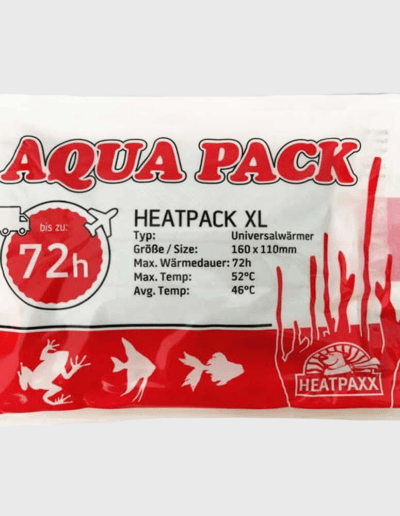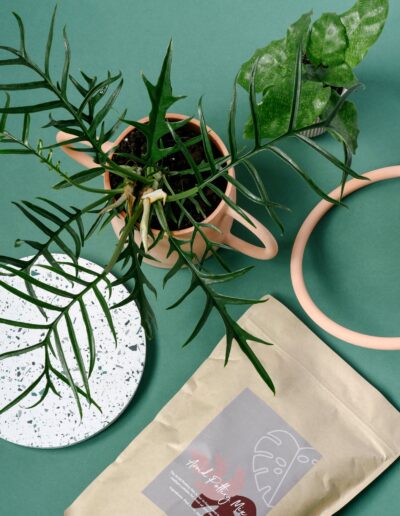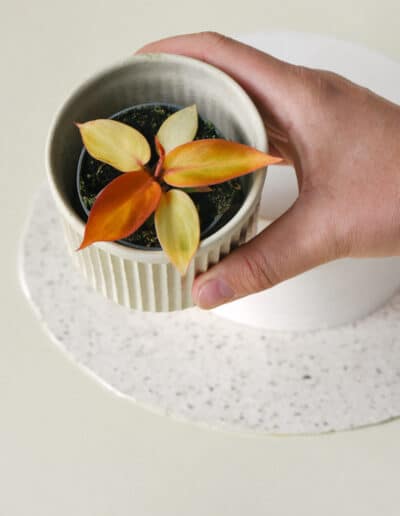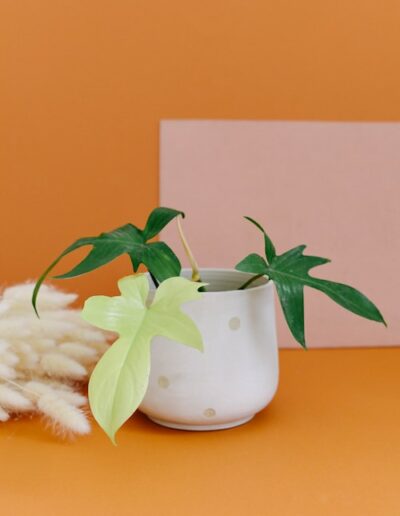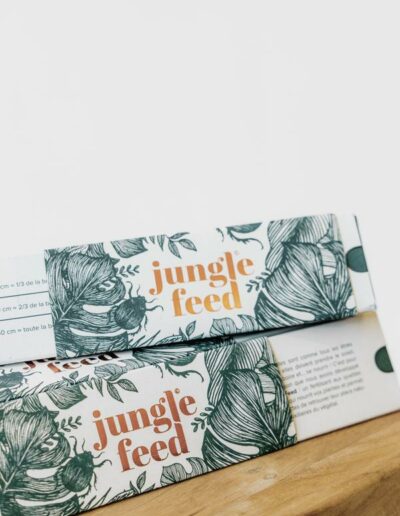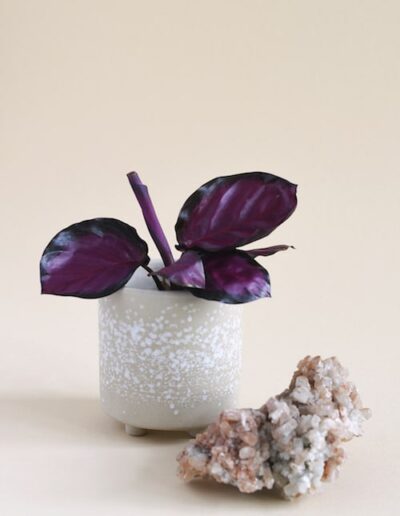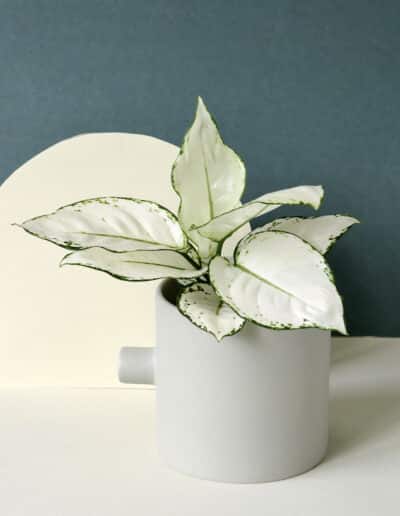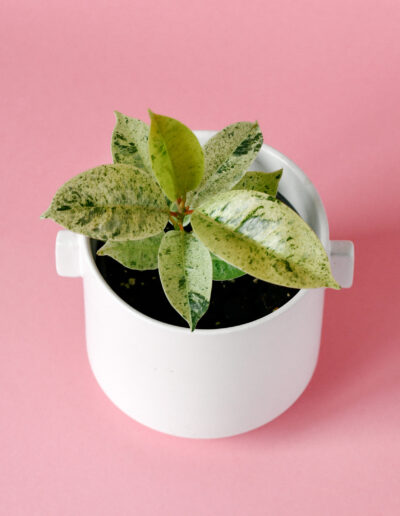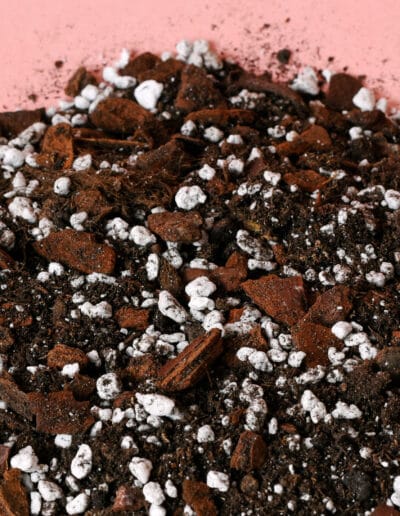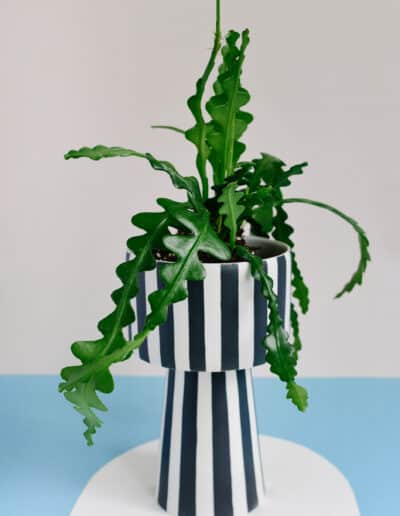Description
Hoya Imbricata is a rare wax plant with very round, silver-splashed leaves. It is a prolific climber. In nature, Hoyas love to grow up tree trunks and along branches as a shingling plant. However, you can also grow it in hanging baskets, or on a trellis. Native to tropical Asia, it is a particularly unique Hoya for its decorative, bowl-shaped leaves that grow up to 25 cm in diameter.
Hoya Imbricata is considered an ant plant, because it forms a special symbiosis with these animals in nature. Ants colonise the spaces beneath the leaves, often using adjacent leaves to serve as nurseries, food storage and other specialised rooms for the ant colony. The Hoya, in turn, will absorb nutrients from the detritus in the ant colony and carbon dioxide which they exhale.
Hoya Imbricata produces champagne-coloured clusters of flowers, but needs the right conditions to bloom. Place your plant in a spot where it gets a lot of light. We recommend that you don’t repot the plant, because the stress of being root-bound encourages Hoya to bloom. Fertilize it regularly! Pruning the plant’s stems in late winter will allow it to become bushier and make it more likely for it to produce flowers.
Hoya Imbricata, like all members of the Hoya family are very kind to their owners, requiring less frequent watering and attention than most tropical indoor plants. They prefer not to have wet feet, so keep them in a well-draining potting mix, preferably a Hoya specific mix. Give them a warm, bright and medium-humidity environment and your Hoya will give your years of love in return!
If you’re into Hoyas (and who isn’t?!) then you should also see Hoya Australis Tricolor, Hoya Carnosa, Hoya Kerii or Hoya Calistophylla.
For more detailed information on Hoya and their care, check out our blog post on the topic!
Also check out our wide range of Hoya! We can particularly recommend our best-selling Hoya Carnosa Krimson Queen and the rarely-offered Hoya Finlaysonii.
Size
The plant is approximately 5cm long and it comes rooted in coconut husk. It can be planted into Hoya potting mix together with that husk.
Disclaimer
An example picture gives a trustworthy image of the plant with good care. The plant at the example picture is not the plant that will be delivered. This is an example, so variations are possible. The eventually delivered plant may differ in for example size, number of flower branches, etc.
Delivery Time
Processing time: up to 7 days
Delivery time:
Germany 1-3 days
For all other countries delivery time can range from 3-10 days.
At the moment we are processing the orders Monday to Wednesday – so if you order from us on a Wednesday it won’t be processed until the following week.
Due to bio laws our plants are shipped only to the countries of European Union and Switzerland. Shipping fee includes packaging and handling costs. All parcels are sent with a tracking number. We cannot guarantee specific delivery times. Please note: we aim to get all orders shipped within 7 working days from the date of order.
To avoid plants being held up in the post, we only post them out Monday to Wednesday (depending on the season) if shipping inland Germany or Mondays only when shipping in EU.
When ordering in winter, please know that we ship our plants with heat packs included in the package. We can however postpone the shipment if the temperatures go below 0.
Please note that some damage can occur during transit on occasions, despite our best efforts to package our plants ready for travel. We hope you understand if that does by chance occur.
Hoya Care Tips
For more detailed Hoya care tips please go here.
Watering
Be sure to water your Hoya thoroughly, so the entire soil becomes wet. They like to dry out more than most plants, so only water them again once the soil is thoroughly dry. If they do not dry out between waterings, they will rot quite easily.
Soil
Hoyas will appreciate a lightweight and very airy potting mix. A mixture of substrate, perlite and bark, such as it can also be found in our Aroid Potting Mix, will work great for most Hoyas. Epiphytic Hoyas in particular will also do well in spaghnum moss.
Hoyas can also be grown in semi-hydro substrates, such as Leca or PON or our Alocasia Mix, since they are particularly aerate.
Light
The more succulent varieties with fleshy leaves, such as Hoya Kerrii or Hoya Calistophylla, can withstand full sun, so they will do great in a South-facing window or right under a small grow light. Meanwhile, thinner-leaved Hoyas, such as Hoya Bella or Hoya Krohniana, will appreciate medium to bright indirect light.
Certain Hoya varieties might begin to redden their leaves due to sun stress, such as Hoya Wayetii Tricolor, for instance. This can be beautiful, but you have to be careful not to overdo it light-wise or it will fully burn the plant and permanently damage the chlorophyll in the leaves in the process.
Humidity
Most Hoyas will do great in moderate humidity of 40-60%. Especially the more thick-leaved Hoya are not too finicky in terms of humidity, but most will thrive and grow faster if given a bit more.
Some of the thinner-leaved varieties might require higher humidity of 60-80% to thrive. They will do especially well in a greenhouse or terrarium environment.
Repotting
Hoyas like to be rootbound, so we recommend that you do not repot your Hoya all too often. Refreshing their substrate every two to three years in order to give them better, nutrient-retaining soil is enough. If they are very rootbound, you can give them a bigger pot when you refresh the substrate.
Flowering
Hoyas won’t flower unless it is given the right care and conditions. Light is the most important factor in getting your Hoya to bloom. It will need a location with bright, indirect light, sheltered from direct sun rays. Fertilising your Hoya regularly may encourage the plant to produce flower buds as well.
Toxicity
Hoyas are NOT toxic to humans or animals when ingested.
Shipping
Delivery costs are based on the total weight of your order and are automatically calculated in the cart. Simply place the products you want to buy into your card and click on “checkout” to get a quote for shipping.
We offer free delivery in Germany for orders above 60€ and EU above 100€.
It takes 1 to 2 working days for us to process your order. Once it is shipped, the following times apply:
| Countries | Shipping times (working days) |
| Austria | 3 to 5 |
| Belgium | 1 to 2 |
| Bulgaria | 4 to 6 |
| Croatia | 5 to 8 |
| Cyprus | 4 to 6 |
| Czech Republic | 3 to 6 |
| Denmark | 2 to 3 |
| Estonia | 4 to 6 |
| Finland | 3 to 6 |
| France | 2 to 4 |
| Germany | 2 to 3 |
| Greece | 3 to 6 |
| Hungary | 3 to 6 |
| Ireland | 2 to 4 |
| Italy | 2 to 5 |
| Latvia | 3 to 6 |
| Lithuania | 4 to 6 |
| Luxembourg | 1 to 2 |
| Malta | 3 to 6 |
| Netherlands | 1 to 2 |
| Poland | 2 to 4 |
| Portugal | 3 to 5 |
| Romania | 3 to 6 |
| Slovakia | 3 to 6 |
| Slovenia | 2 to 4 |
| Spain | 3 to 5 |
| Sweden | 2 to 5 |
| Switzerland | 3 to 4 |
Hoya Imbricata
15 €
Hoya Imbricata is a rarely found wax plant with very round, silver-splashed leaves and a prolific climber. Native to tropical Asia, it is a particularly unique Hoya for its decorative, bowl-shaped leaves that grow up to 25 cm in diameter.
OUT OF STOCK
OUT OF STOCK
15 €
Hoya Imbricata is a rare wax plant with very round, silver-splashed leaves. It is a prolific climber. In nature, Hoyas love to grow up tree trunks and along branches as a shingling plant. However, you can also grow it in hanging baskets, or on a trellis. Native to tropical Asia, it is a particularly unique Hoya for its decorative, bowl-shaped leaves that grow up to 25 cm in diameter.
Hoya Imbricata is considered an ant plant, because it forms a special symbiosis with these animals in nature. Ants colonise the spaces beneath the leaves, often using adjacent leaves to serve as nurseries, food storage and other specialised rooms for the ant colony. The Hoya, in turn, will absorb nutrients from the detritus in the ant colony and carbon dioxide which they exhale.
Hoya Imbricata produces champagne-coloured clusters of flowers, but needs the right conditions to bloom. Place your plant in a spot where it gets a lot of light. We recommend that you don't repot the plant, because the stress of being root-bound encourages Hoya to bloom. Fertilize it regularly! Pruning the plant's stems in late winter will allow it to become bushier and make it more likely for it to produce flowers.
Hoya Imbricata, like all members of the Hoya family are very kind to their owners, requiring less frequent watering and attention than most tropical indoor plants. They prefer not to have wet feet, so keep them in a well-draining potting mix, preferably a Hoya specific mix. Give them a warm, bright and medium-humidity environment and your Hoya will give your years of love in return!
If you're into Hoyas (and who isn't?!) then you should also see Hoya Australis Tricolor, Hoya Carnosa, Hoya Kerii or Hoya Calistophylla.
For more detailed information on Hoya and their care, check out our blog post on the topic!
Also check out our wide range of Hoya! We can particularly recommend our best-selling Hoya Carnosa Krimson Queen and the rarely-offered Hoya Finlaysonii.
Size
The plant is approximately 5cm long and it comes rooted in coconut husk. It can be planted into Hoya potting mix together with that husk.
An example picture gives a trustworthy image of the plant with good care. The plant at the example picture is not the plant that will be delivered. This is an example, so variations are possible. The eventually delivered plant may differ in for example size, number of flower branches, etc.
Processing time: up to 7 days
Delivery time:
Germany 1-3 days
For all other countries delivery time can range from 3-10 days.
At the moment we are processing the orders Monday to Wednesday – so if you order from us on a Wednesday it won’t be processed until the following week.
Due to bio laws our plants are shipped only to the countries of European Union and Switzerland. Shipping fee includes packaging and handling costs. All parcels are sent with a tracking number. We cannot guarantee specific delivery times. Please note: we aim to get all orders shipped within 7 working days from the date of order.
To avoid plants being held up in the post, we only post them out Monday to Wednesday (depending on the season) if shipping inland Germany or Mondays only when shipping in EU.
When ordering in winter, please know that we ship our plants with heat packs included in the package. We can however postpone the shipment if the temperatures go below 0.
Please note that some damage can occur during transit on occasions, despite our best efforts to package our plants ready for travel. We hope you understand if that does by chance occur.
For more detailed Hoya care tips please go here.
Watering
Be sure to water your Hoya thoroughly, so the entire soil becomes wet. They like to dry out more than most plants, so only water them again once the soil is thoroughly dry. If they do not dry out between waterings, they will rot quite easily.
Soil
Hoyas will appreciate a lightweight and very airy potting mix. A mixture of substrate, perlite and bark, such as it can also be found in our Aroid Potting Mix, will work great for most Hoyas. Epiphytic Hoyas in particular will also do well in spaghnum moss.
Hoyas can also be grown in semi-hydro substrates, such as Leca or PON or our Alocasia Mix, since they are particularly aerate.
Light
The more succulent varieties with fleshy leaves, such as Hoya Kerrii or Hoya Calistophylla, can withstand full sun, so they will do great in a South-facing window or right under a small grow light. Meanwhile, thinner-leaved Hoyas, such as Hoya Bella or Hoya Krohniana, will appreciate medium to bright indirect light.
Certain Hoya varieties might begin to redden their leaves due to sun stress, such as Hoya Wayetii Tricolor, for instance. This can be beautiful, but you have to be careful not to overdo it light-wise or it will fully burn the plant and permanently damage the chlorophyll in the leaves in the process.
Humidity
Most Hoyas will do great in moderate humidity of 40-60%. Especially the more thick-leaved Hoya are not too finicky in terms of humidity, but most will thrive and grow faster if given a bit more.
Some of the thinner-leaved varieties might require higher humidity of 60-80% to thrive. They will do especially well in a greenhouse or terrarium environment.
Repotting
Hoyas like to be rootbound, so we recommend that you do not repot your Hoya all too often. Refreshing their substrate every two to three years in order to give them better, nutrient-retaining soil is enough. If they are very rootbound, you can give them a bigger pot when you refresh the substrate.
Flowering
Hoyas won’t flower unless it is given the right care and conditions. Light is the most important factor in getting your Hoya to bloom. It will need a location with bright, indirect light, sheltered from direct sun rays. Fertilising your Hoya regularly may encourage the plant to produce flower buds as well.
Toxicity
Hoyas are NOT toxic to humans or animals when ingested.
Delivery costs are based on the total weight of your order and are automatically calculated in the cart. Simply place the products you want to buy into your card and click on “checkout” to get a quote for shipping.
We offer free delivery in Germany for orders above 60€ and EU above 100€.
It takes 1 to 2 working days for us to process your order. Once it is shipped, the following times apply:
| Countries | Shipping times (working days) |
| Austria | 3 to 5 |
| Belgium | 1 to 2 |
| Bulgaria | 4 to 6 |
| Croatia | 5 to 8 |
| Cyprus | 4 to 6 |
| Czech Republic | 3 to 6 |
| Denmark | 2 to 3 |
| Estonia | 4 to 6 |
| Finland | 3 to 6 |
| France | 2 to 4 |
| Germany | 2 to 3 |
| Greece | 3 to 6 |
| Hungary | 3 to 6 |
| Ireland | 2 to 4 |
| Italy | 2 to 5 |
| Latvia | 3 to 6 |
| Lithuania | 4 to 6 |
| Luxembourg | 1 to 2 |
| Malta | 3 to 6 |
| Netherlands | 1 to 2 |
| Poland | 2 to 4 |
| Portugal | 3 to 5 |
| Romania | 3 to 6 |
| Slovakia | 3 to 6 |
| Slovenia | 2 to 4 |
| Spain | 3 to 5 |
| Sweden | 2 to 5 |
| Switzerland | 3 to 4 |

























